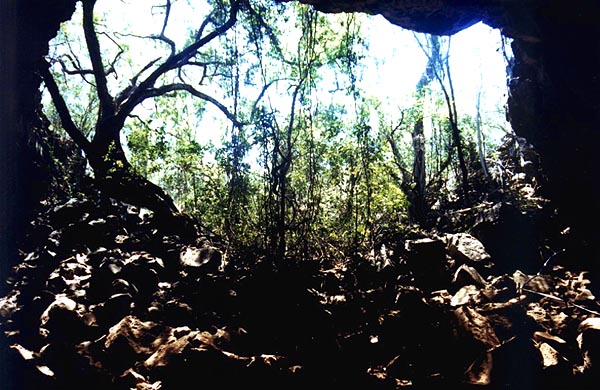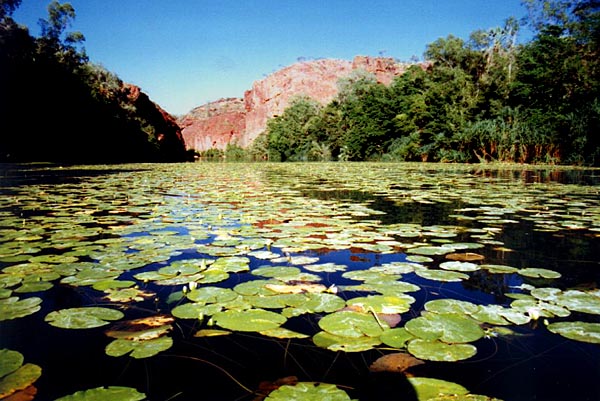|
Before leaving for the Gulf, Kevin and Barbara, Karen and I had one more tourist duty to perform - the Skyrail trip from Cairns to Kuranda. We had all been to Kuranda from Cairns on the train, but the Skyrail promised a new experience. It not only travelled through the rainforest, but above it as well. In addition, it stopped along the way, allowing a walk and a visit to an information centre.
To reduce the cost, we all shared two return tickets. Karen and I dropped Kevin and Barbara at the Skyrail terminal in Cairns, saw them on their way and then drove up to Kuranda to await their arrival. We all visited the Kuranda markets, enjoyed the screams of the girls on the bungee jump and then returned to Cairns, with Kevin and Barbara driving and Karen and I taking the return Skyrail trip. The project originally attracted a lot of protest from the Green lobby, but we could see no reason for the furore. Damage to the rainforest was almost non-existent, and more than made up for by the increased awareness and appreciation of all those who took the trip.
Next morning we packed the car, completing the job by 8am. We retrieved our bikes from Karen and Len, the caravan park managers, and strapped them carefully and securely to the roof rack. Two hundred and seventy kilometres later, we were camped at Undara.
We all paid for a full day tour of the lava tubes. The seventy dollar cost was fairly extravagant, but the tour was well worth the expense, primarily due to the expert commentary by Val Speedie (nee Litchfield) - a real bushie. She gave us excellent and inspirational information on the history of the park, the trees, birds, other flora and fauna, and of course, the lava tubes themselves. Lunch was included - cold meat, salad and veggies, and even beer and Chardonnay.

Inside a lava tube looking out
The afternoon was spent listening to Manly lose the Rugby League grand final. Despite the loss, we broke out the two bottles of champagne we had bought especially for the occasion, and enjoyed a long "happy hour." A particular delight for me was watching the antics of an ant for about twenty minutes. It had discovered a quarter of a peanut under our happy-hour table, and proceeded to carry it back to its nest. I followed its trials and tribulations for about thirty metres as it lugged its prize over stones, through grass and across a road, hardly deviating an inch from the direct line home. How do they do that?
Kevin, Barbara and I shared the driving the next day, and I got the raw end of the deal. Barbara drove to Georgetown over really good roads, Kevin drove from Georgetown to Croydon over even better roads, then I drove from Croydon to Normanton over diabolically bad roads. In my diary I called it an eight wheel drive road - twice as bad as a four wheel drive road. It was punctuated with detours to the left and right, perforated with bulldust holes, corrugated and even flooded in some places. Then Kevin took over for the flat, straight, smooth, black soil plain between Normanton and Karumba. I could not take a trick!
Karumba is a great place to visit if you like fishing, otherwise it is a complete non-event. Karen and I and the Inlaws still have fond memories of Karumba, however, because of a free barbecue that began shortly after our arrival which featured a forty three kilogram mulloway caught by John and Maureen, a couple of residents of the caravan park. With nothing to keep us in Karumba, we drove out early the next morning for a day of travel, four hundred and ten kilometres to Gregory Downs.
After having a look at the pub we drove down to the river and set up camp. It was not long before we noticed a lot of bird activity in the area, so out came the binoculars. The next half hour produced the most amazing birdwatching Karen and I have ever experienced. Everywhere we looked there seemed to be a new bird! Crimson Finches, Yellow-throated Miners, Rufous-throated Honeyeaters, black chinned Honeyeaters, Masked Finches, Diamond Doves, Restless Flycatchers, a new race of White-browed Robin, a probable sighting of a Purple-crowned Fairy-wren, and throw in sightings of Budgerigars and Pheasant Coucals as well. Karen and I were rapt.
Ninety seven kilometres of driving the next day brought us to Lawn Hill National Park, the road getting progressively worse the closer we got to the park, until the final few hundred metres which were really shocking. The campground was lovely, though, and the Lawn Hill Gorge was stunning, an incredible green oasis in a flat, brown, spinifex desert. After setting up our tents, we walked down to the rapids at the lower end of the main gorge for a combined spa and swim, then climbed up onto the escarpment of Island Stack for views and photographs up into the gorge. After lunch, we walked in the opposite direction to Indarri Falls, stopping at three or four lookouts along the way. At the falls, which are only a couple of metres high, we had a great swim in the warm waters of Lawn Hill Creek, then returned to camp at dusk via an alternate track.

Lawn Hill gorge
The next morning I hired a three-person canoe and paddled it up to a set of steps that led from the water to the camping ground, to pick up Karen and Barbara. We made our way up through the gorge, marvelling at the bright red cliffs on our way to the Indarri Falls. Although they look like rock, the falls are actually composed of a substance called tufa, a delicate substance made up of deposits of calcium carbonate present in the highly mineralised waters of Lawn Hill creek. A portage has been constructed at one end of the falls, to protect the tufa dam and to assist paddlers making their way between the upper and main gorges. While the main gorge is about two kilometres long, the second gorge is much shorter, only a few hundred metres. At its end, the passage through to the third gorge is protected by stands of pandanus palms, which must be negotiated with care. Once through, we paddled another couple of hundred metres to the end of the upper gorge. Here the deep water ends and the creek becomes too shallow for successful navigation. We backtracked a little way, found a gap in the foliage lining the bank and clambered ashore, climbing up to the top of nearby cliffs for beautiful views in all directions. Back at Indarri, we all enjoyed a leisurely swim before returning the canoe to the start of the main gorge, checking in just short of four hours.
During lunch, a conversation between Karen and ranger Colin caused a major change of direction in the course of our lives. The conversation started out quite innocently.
"This is an unbelievable place you've got here," said Barbara.
"Thanks. We like it."
"How many rangers work here at the national park?" asked Karen.
"About half of them," Colin answered, grinning through his bushy red beard. He was a cheeky bugger. "We actually have four full-time rangers," he continued. "My wife and myself, and two others."
"Do you ever take volunteers here?" asked Karen. Where had that question come from, I thought. It was a decisive moment.
"We sure do! We've had a young guy called Geoff working here for a while, but he leaves in two days and we have nobody to replace him. Are you interested?"
"Maybe," Karen answered. "What's the deal?"
"Basically, we provide you with living quarters containing all the mod cons like a refrigerator, a freezer, stove, air conditioning. Your electricity and work clothes are provided free as well. All you have to do is provide your own food, and work about four hours a day."
"What sort of work?"
"Apart from paperwork in the office, and handling money, you would basically be doing all the same sort of things as a normal national park ranger. When can you start?"
"Can we think it over for a while and let you know?"
"Sure."
Karen and I discussed our options. If we decided not to accept the offer, we could get a lift with the Inlaws out to Mount Isa and cycle back to Sydney through central Queensland and New South Wales. This would take us about two months, and get us back to Sydney in time for the Lord Howe sailing trip. The timing was right, but none of the twenty four places in Australia we really wanted to visit lie along this vast stretch of hot, dry road. We would simply be filling in time until the start of the sailing trip.
On the other hand, if we stayed at Lawn Hill National Park, we would be resident at one of those twenty four places for two months, and would come to know the place intimately. It might also provide further opportunities for similar work, and give us an idea whether we were suited to the life of national park rangers. At the end of the two months we could then return to Sydney by bus. We talked it over with Kevin and Barbara, who said it was a chance too good to miss, and that we should go for it. They agreed to take our bikes back to Sydney with them, so there was nothing to prevent us from staying.
Once I had recovered from the initial shock of the suddenness of the opportunity, I became my usual gung-ho self and said "Let's do it!" Karen was obviously keen as well, otherwise she would not have asked the question about volunteers in the first place. But Karen almost never makes snap decisions. A true Virgo, she likes to analyse decisions from all angles, weighing the pros and cons, checking all the figures, considering all the possibilities. I knew she would eventually agree to become a volunteer - after all, it was the kind of opportunity that we had hoped would occur once we started travelling. We had always kept our plans fairly fluid and short-term, just in case this sort of thing presented itself. I just had to wait for Karen's head to catch up with her heart.
After lunch Karen and I swam across the creek, about fifty metres, and walked up to the base of the escarpment to Rainbow Dreaming, a primitive and rather unimpressive aboriginal art site. Later, we walked down to another site near the lower gorge, Wild Dog Dreaming, which was better, but not much. We walked down to the water's edge. A freshwater croc, about a metre and a half long, was sunning itself on a log protruding from the water. A family of purple-crowned Fairy-wrens chattered noisily in a thick stand of pandanus. Blue winged kookaburras tried valiantly, but unsuccessfully, to imitate the laughing calls of their southern cousins. Why would you want to be anywhere else?
That evening, sometime between my favourite time of day - happy hour - and Karen's favourite time of day - dinner - we officially decided to become volunteer rangers at Lawn Hill. During the next two months we would learn everything we wanted to know about working in a national park, and then some. Most of it was good, some of it was bad, some of it was unbelievable, but all of it was interesting.
|

